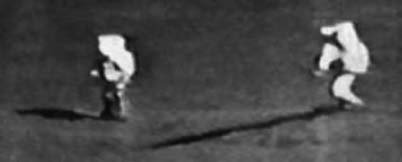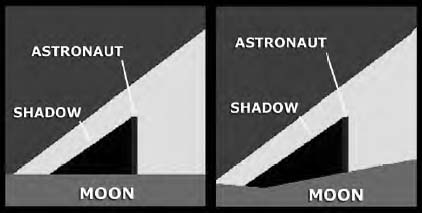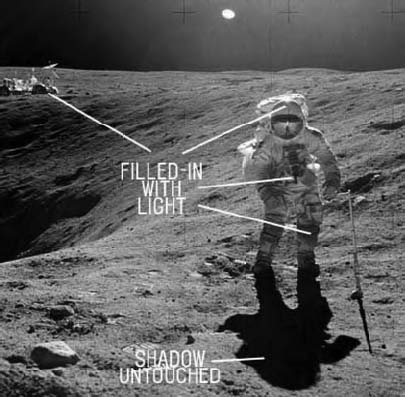Ancient Aliens on the Moon (21 page)
Read Ancient Aliens on the Moon Online
Authors: Mike Bara

I have been accused, along with Mr. Hoagland, of defending NASA on this count only because I need a legitimate manned lunar program to support my Ancient Alien theory. I hope this chapter will make it clear there simply is no logical basis for the faked Moon landing conspiracy theory.
Let me be clear; I am unabashedly a conspiracy theorist. I am 100% convinced that there has been a cover up by NASA of some extraordinary discoveries made in the course of the agency’s 40-year year history, and I think the data we’ve already covered in this book proves that. That said, one thing they did not do – unquestionably—was fake the Moon landings. In fact, most of the charges made, not just by Collier and Percy, but by others who have picked up the mantle of their assertions, are so absurd, so easily discredited, so lacking in any kind of scientific analysis and just plain common sense that they give legitimate conspiracy theories—like mine—a bad name. Frankly, I suspect that may ultimately be the point of this whole thing after all.
Almost from the moment that Neil Armstrong and Buzz Aldrin set foot upon the Moon at Tranquility Base, the rumors began circulating that the whole thing was faked. I have always felt that there was something a little more to this than simple stupidity or naïveté, something a bit insidious about the whole thing. That was more than confirmed in the Forward to
Dark Mission
, when Richard related his memories of being handed a pamphlet claiming the landings were faked even before Neil and Buzz had splashed down on their return trip from the first lunar landing. What made that moment so extraordinary was not that someone had made up a pamphlet making such a claim, it was that the person who authored it was being escorted around the NASA press room by a NASA press officer to make sure every reporter got one.
So yeah, the rumor that the Moon landings were faked was actually started with the able assistance of NASA itself more than 4 decades ago.
I assumed that as time went by, the notion would weaken and falter, rather than gain momentum as it has recently. I have come to wonder, given my own stance on the whole question of what the Moon program was really about and what the astronauts really found, if there wasn’t perhaps something a bit “conspiratorial” about the promotion of this patently absurd and demonstrably false conspiracy theory. Richard’s story, recounted as I said in more detail in
Dark Mission
, all but confirms that.
As you will see, some of the specific citations of evidence that the landings were faked can actually be more easily explained not just by a complete rejection of the Moon Hoax theory, but a combination of conventional explanations and the glass ruins model of the Moon. The way light scatters on the Lunar surface; the size of solar reflections in the visors of the astronauts (which are way out of proportion to their counterparts on modern day Space Shuttle missions), the sometimes secretive stance taken by the astronauts and the Agency; the very peculiar qualities of the film in the cameras taken to the Moon by the astronauts, all point to something bigger and more interesting then we have been led to believe by NASA itself. In this chapter, I will try to sort out the most common claims being made, highlight the rebuttal evidence, and show that the Moon landings were something quite extraordinary after all.
There are three major thrusts used by the fake landing advocates to bolster their claim: First, that the radiation exposure suffered by the astronauts was not survivable; second, that the photographic evidence “proves” that the landings were staged in a Disney movie studio somewhere; and third, that the mechanical aspects of the mission—the pure mechanics and physics of the journey—are not as claimed and therefore must be faked.
Each of these claims is based on misinterpretations, misrepresentations, or just plain ignorance of the realities of space travel. It is not a coincidence that many of the believers in this myth are too young to actually remember the Moon landings. If they had been old enough to watch the missions on live TV, they would have known that most of these claims are nonsense. For this article, we will deal with each of these claims in separate sections, and try to directly address the key sub-claims being made.
Percy is one of the primary drivers of this particular set of claims, but Collier and others have added to it. Let’s list a few of the claims one-by-one and address them.
Claim 1 – The shadows don’t fall right in images taken on the lunar surface, proving that there are multiple light sources, like professional stage lighting using high- powered lamps. Since the Moon has only one light source, the Sun, these images (these people claim) “have to have been shot on a sound stage somewhere.”
This one is usually based on images like the one above (taken from an Apollo 17 TV transmission), that seem to show the shadows of the astronauts coming from different lighting sources. However, a logical approach to this problem reveals that there is nothing at all mysterious about either the shadows or the light sources. If, in fact, the shadows were cast by different light sources, each astronaut would have two shadows instead of just the one each we see here. Yet, in the images that the “Moon Hoaxers” cite, there is consistently only one shadow being cast, indicating that the Sun is (as it should be) the single and dominant light source.
So, how to explain the seemingly divergent shadows in this image? If you look closely, you will see that the astronaut on the right is on a slight rise above the astronaut on the left. This has not only the effect of lengthening his shadow, but also if the slope is greater in one direction, say to the left of the astronaut on the right, it will tend to flow and elongate in that direction.
It’s important to keep in mind that the Moon has a very rough and uneven surface, with lots of slopes, rises and potholes. As a result, many of the shadows will appear to be non-parallel.

Shadows cast in divergent directions from Apollo 17 TV broadcast.

The geometry of shadows.
In a sense, the Moon Hoax advocates are correct here; there is no comparison to be made from lunar landscapes and terrestrial ones. But, it is because the surface of the Moon is so uneven, not because there are multiple light sources, i.e. lamps, casting the “wrong” shadows.
Also at issue is the photographic equipment used by the astronauts on the lunar surface. Shortened wide-angle lenses, like the ones on the hand-held Hasseblad 70mm cameras used by the astronauts, will distort otherwise parallel shadows. Simply pull some outdoor photos from your own personal collection and see for yourself.
Claim 2 – The foreground of many images of the astronauts on the Moon are filled in with light, while the shadows remain absolutely black, again proving that there are multiple light sources.
In this one, the argument is that with his back to the sun, the astronaut’s suit should be as dark as his own shadow stretching out in front of him (see Apollo 16 image, above). Since there is no light diffusion in an absolute vacuum, NASA “must” therefore have used reflectors or fill-in lamps to illuminate the astronaut for this photograph. The truth is, there
is
evidence of a “reflector” in this image—but it’s the lunar surface itself.
Obviously, the lunar surface is a fairly bright gray color. It is known, from the Apollo samples brought back and analyzed in Houston, to contain a LOT of glass beads and metals like aluminum and titanium, with a lot of other reflective and refractive minerals in it. All of these materials tend to kick light directly back toward the source of illumination with very high efficiency. This is one reason why the Full Moon is so much brighter (than other phases) in the night sky; the sun is “behind” the Earth. The effect of the sunlight hitting the lunar surface and being reflected back toward the sun itself creates a backscatter that fills in the astronaut’s bright white shadowed suit with an excellent fill-light effect. And the fact that the shadow is so dark on the ground in front of him is proof of exactly the opposite of the claim being made by the “Moon Hoaxer” crowd. It shows that indeed, the astronaut is standing upright in a harsh vacuum, where his suit can “see” the illumination from the surrounding lunar landscape. By stark contrast, almost no light at all has seeped into the shadow, because it’s lying flat on the ground and cannot “see” anything but black space overhead. It is, as it should be, extremely dark and sharp.

Light scattering off the lunar surface.
Interestingly, as to the question of multiple light sources, some of the leading debunkers of the Moon Hoax theory, like Dr. Phil Plait, have also made a very significant mistake. It is flat wrong, as many of them have stated, that the Earth is a “very significant” light source on the Moon. When full, the Earth is on the order of 68.4 times brighter than a full Moon as seen from Earth. It also takes up something like 13.5 times as much sky. But, that’s not the whole story.
The Earth is—maximum—100 times the brightness of a Full Moon (I’m going to overestimate a bit to prove the point). The apparent magnitude (brightness) of a Full Moon is about -13. The equivalent magnitude of the Sun is about -27. Subtracting, that’s a difference of 14 magnitudes. Since each 5 orders of magnitude correspond to a factor of 100 in brightness, a difference of 14 magnitudes corresponds to almost 100 X 100 X 100, or a factor of a million. Allowing for the ~100 times greater reflected brightness of the Earth (at “Full Earth”) the direct lunar sunlight is still at least 100,000 times brighter than the Earth’s illumination.
There is no way that the slide films used by the crews could have detected that feeble amount of “Earthlight” on the lunar surface, even in the shadows, because the exposures were set for the full, sunlit view.
Of course, we have our own thoughts on this. Some of the debunkers must be realizing that backscatter is insufficient to account for some of what we are seeing on the lunar surface photography. To come up with an explanation, they have resorted to the (obviously incorrect) “Earth light” angle. But of course, it’s really more interesting than that…
Claim 3 – There are no stars in the background from pictures taken on the Moon.
This one keeps coming up, but the answer, while obvious, is somewhat complicated by our own lunar conspiracy theory. Usually, Moon Hoax advocates cite any number of pictures of the lunar surface showing an absolute black background, but this one above of John Young saluting the flag in front of the LM Orion is quite prevalent. Anyone with the slightest knowledge of photography can easily put this one to rest.
On an airless body like the Moon, any brightly lit foreground object must be photographed with a very short exposure time. Otherwise, the image will be badly overexposed. Any background pinpoint light sources—like, say, stars that are literally trillions of miles further away—will not show up at all. Likewise, if the photographer wants to capture the background stars, he is going to have to use a very long exposure time, which means that the foreground will be totally washed out in one blob of overexposed light. Obviously, there would be no real benefit to taking such an image, since the point of the lunar surface photography was to document the activities of the astronauts on the lunar surface—not to stargaze.